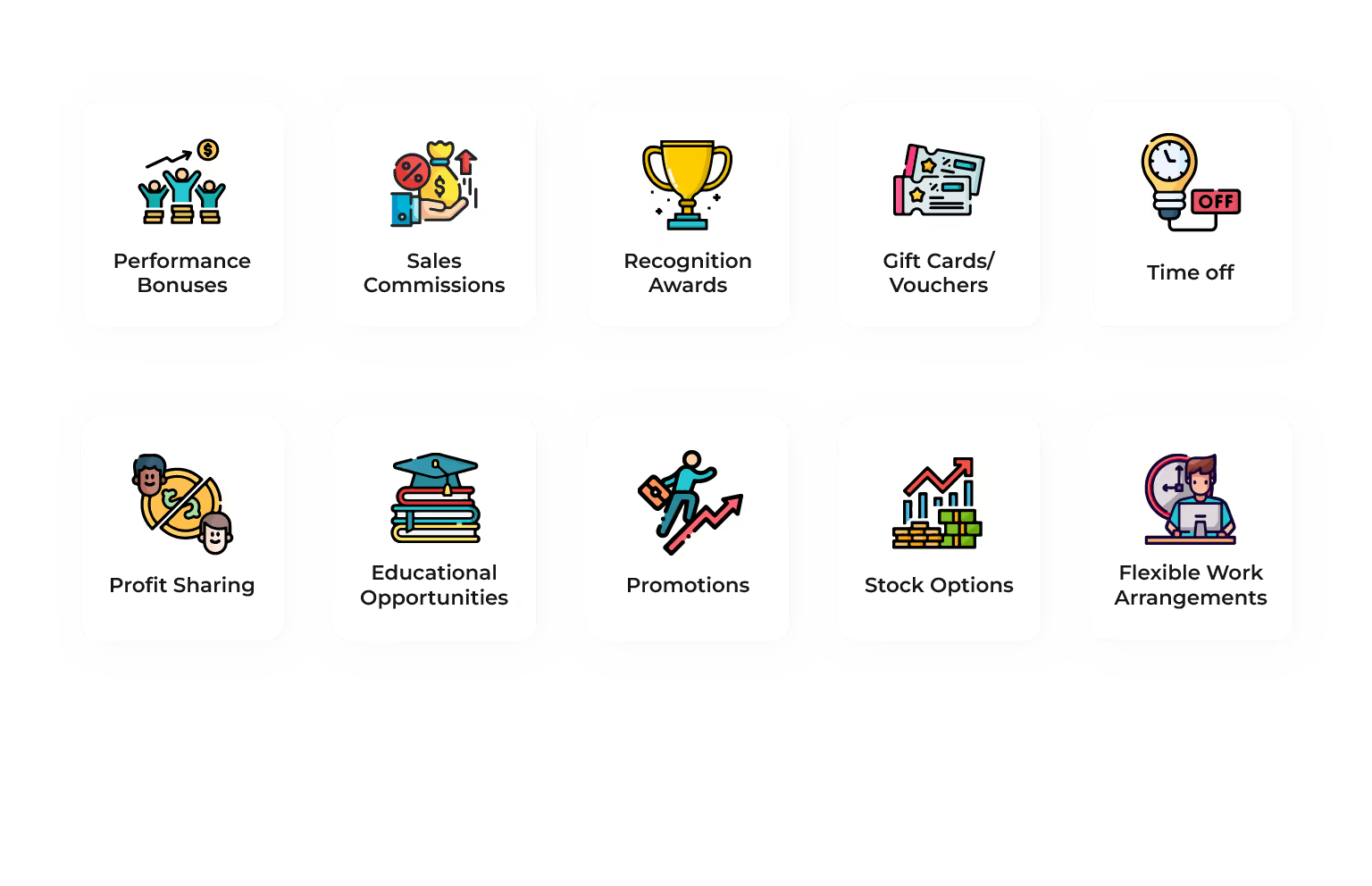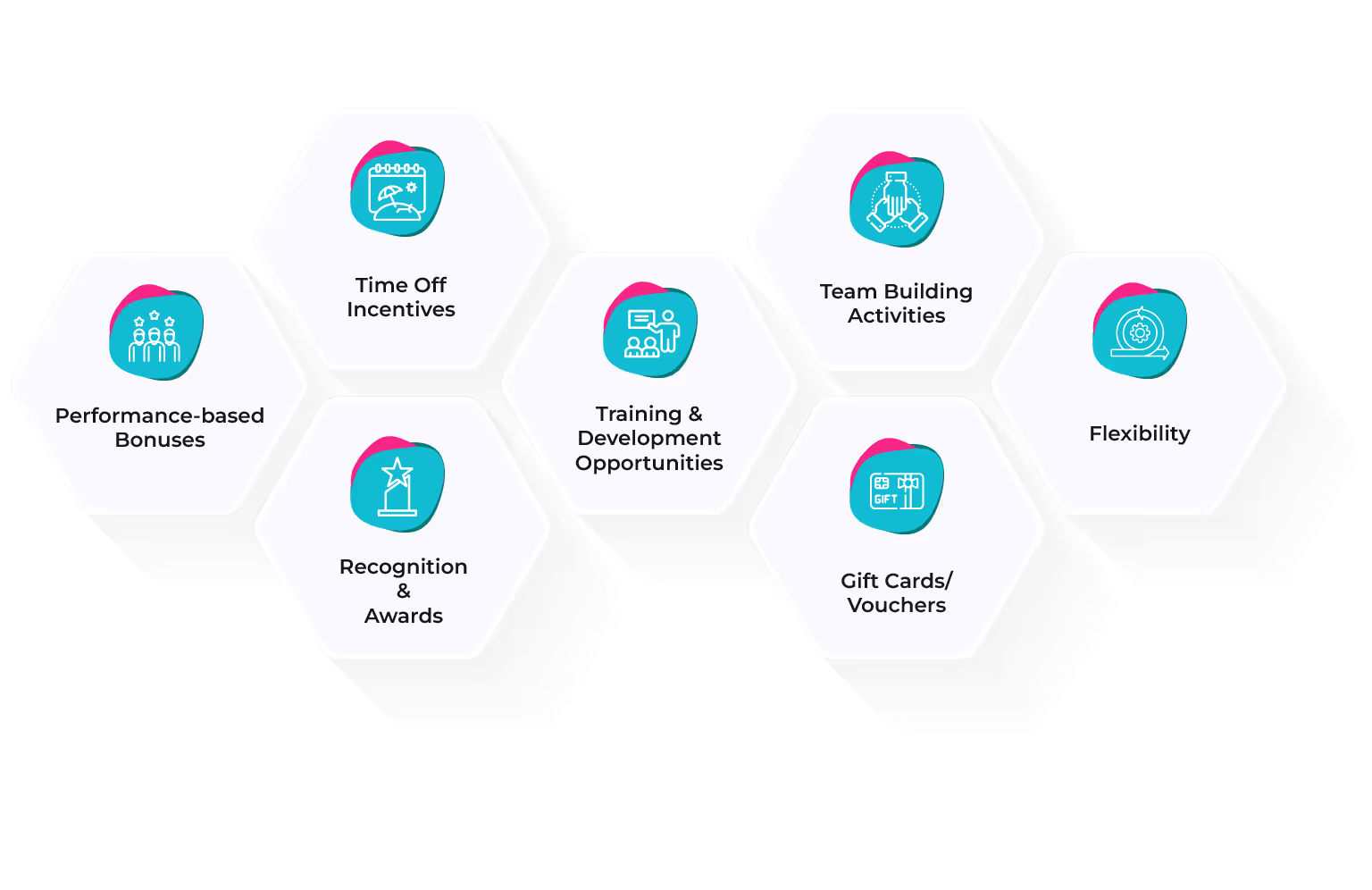
Blog
Team Incentives vs Individual Incentives: A Comparison
April 3, 2023


Key Insights
Preface:
In today's competitive business environment, companies are constantly searching for ways to increase productivity and drive results.
One strategy that many organizations use is the implementation of incentive compensation plans, which are rewards or bonuses that are given to employees who meet certain performance goals or milestones.
When it comes to incentives, there are two main approaches: team incentives and individual incentives.
Each has its advantages and disadvantages, and deciding which approach to use can be a difficult decision for companies.
In this blog, we will explore the differences between team and individual incentives, as well as the advantages and disadvantages of commission.
Introduction:
This is the truth: Your salespeople are the pivot around which the future of your company revolves. Are you still asking yourself why it is important to keep them happy?
The answer is actually quite simple. People like to be acknowledged and rewarded for their hard work. It is easy for sales managers to assume that their reps are satisfied with their compensation, but a comprehensive approach that includes broad based compensation structure can help ensure all team members feel valued and fairly compensated, ultimately contributing to a positive sales branding image.
But here is a cold hard fact - 78 percent of workers responded to a Globoforce survey by saying that they would work harder if they felt that their efforts were better recognized and appreciated.
While both individual incentives and team incentives aim to increase productivity and performance, they differ in their focus and effectiveness.
Individual Incentives:
Individual incentives are rewards that are given to individual employees for meeting or exceeding certain performance goals.
The employee incentive program frequently links these incentives to particular metrics like sales targets, customer satisfaction ratings, or productivity levels. Individual incentives encompass diverse forms, such as bonuses, commissions, or stock options.
Types of Individual Incentives:
Here are some examples of individual incentives:

Some examples of team incentives include:
Performance bonuses:
This incentive is given to an employee who has achieved specific performance targets or exceeded expectations.
Sales commissions:
Salespeople are often incentivized with commissions based on the number of sales they make.
Recognition awards:
These awards can take the form of plaques, certificates, or other forms of public recognition or discretionary bonus examples for a job well done.
Gift cards or vouchers:
Employers can provide gift cards or vouchers to employees who achieve certain milestones or goals.

Time off:
Employees may be offered additional time off, such as extra vacation days, for achieving specific goals or objectives.
Promotions:
Promotion opportunities provide employees with the incentive to work harder and develop their skills to advance their careers.
Profit sharing:
Profit sharing incentives give employees a percentage of the company's profits, which can be a strong motivator.
Stock options:
Stock options give employees the option to purchase company stock at a discounted price, which can provide a significant financial incentive.
Educational opportunities:
Employers can incentivize employees by offering educational opportunities, such as tuition reimbursement or professional development programs.
Flexible work arrangements:
Employees may be motivated by the flexibility to work from home or have a more flexible schedule.
Individual Incentives- Advantages
Individual incentive plans can offer several benefits to both employees and organizations. Let us look into the top 5 of these benefits:
Boosts Employee Productivity
Individual incentive plans are rewarded based on the individual performance and achievement of the salesforce. This motivates them to enhance their performance and productivity to achieve their targets and goals timely. When the individual goals are aligned with the larger company objectives, along with individual incentives it ensures the fulfillment of the organizational goals.
Increases Retention
When salesforce are rightly rewarded and valued for their work and achievement, it creates a sense of belonging with the organization. The recognition of their hard work will help ensure employee engagement and thereby retaining the high performing talents within the company.
Cost Effectiveness
Individual incentives reward salesforce for their efforts and achievements. This ensures that the incentive budget is utilized on the high performing sales reps who strategically work towards achieving their quotas. Thus tying incentive KPIs to individual achievements help companies to cost effectively utilize their money without compromising on recognizing their high performers.
Promotes Healthy Competition
Individual incentive plans foster healthy competition among employees. Knowing that there are rewards for outstanding performance can create a positive competitive environment, encouraging individuals to strive for excellence. This competition can lead to increased innovation, higher levels of effort, and a dynamic workplace where employees are continuously pushing their boundaries.
Increases Clarity
Individual incentive plans often have clear and transparent criteria for earning rewards. This clarity ensures that employees understand what is expected of them and how their performance will be measured. It leads to better communication between employees and management, as expectations are clearly defined, and employees can track their progress toward incentive goals.
When designed and executed effectively, individual incentives can contribute significantly to employee motivation, engagement, and overall organizational success.
Individual Incentives- Drawbacks
While individual incentive plans can offer benefits, they also come with potential drawbacks. Here are a few drawbacks associated with individual incentives that organizations must look into:
Hinders Team Collaboration
Individual incentives may create a competitive environment that could undermine teamwork. Employees may become more focused on their personal goals and rewards, neglecting collaborative efforts that are essential for overall organizational success. This can lead to a lack of cooperation and a breakdown in communication among team members.
Encourages Unhealthy Competition
While healthy competition can drive performance, individual incentives may sometimes lead to unhealthy competition among employees. Instead of fostering a supportive environment, it can create a cutthroat culture where colleagues are more interested in outperforming each other than in working collaboratively towards shared objectives.
Risk of Short-Term Focus
Individual incentive plans may encourage employees to prioritize short-term goals over long-term strategic objectives. This can lead to a focus on achieving immediate results to earn rewards, potentially neglecting the importance of sustainable and enduring contributions to the organization's success.
Potential for Biased Evaluation
The measurement of individual performance for incentive purposes may become biased, leading to concerns about fairness. If evaluation criteria are not well-defined or if managers show favoritism, it can result in dissatisfaction among employees who feel that their efforts are not accurately recognized or rewarded.
Neglects Collective Responsibility
Individual incentives can sometimes shift the emphasis away from the collective responsibility of a team or organization. Employees may become more concerned with their achievements and rewards, neglecting the importance of contributing to the overall success of the team or company. This can hinder the development of a strong organizational culture centered around shared goals.
It's essential for organizations to carefully consider the potential drawbacks of individual incentive plans, weigh them against the benefits, and strive to strike a balance between individual and team-based incentives.

Team Incentives:
Team incentives are rewards or bonuses given to a group of employees who work together towards a common goal.
The idea behind team incentives is that when employees work together towards a common goal, they are more likely to be motivated to perform at their best. By offering incentives that are tied to the success of the team as a whole, each member of the team is motivated to work harder, since they know their success depends on the success of the team, often facilitated by tools like a sales battlecard template.
Types of Team Incentives:
Some examples of team incentives include:

Performance-based bonuses:
A bonus can be awarded to the entire team for achieving a specific target or goal. For example, if a sales team meets or exceeds their sales target for a quarter, they could receive a bonus.
Time-off incentives:
Employees can be given extra time off as an incentive. For instance, if a team completes a project before the deadline, they can be given an extra day off.
Team building activities:
Team building activities are a great way to incentivize teamwork. The company can offer a fun team activity, such as a bowling night, paintball tournament, or other team-building exercises. These activities can also be strategically integrated into different types of sales meetings to enhance collaboration and communication among team members.
Gift cards or vouchers:
The team can be given gift cards or vouchers as incentives. For example, a restaurant voucher or a shopping voucher for the entire team.
Recognition and awards:
Recognizing and rewarding team members for their contributions is a great way to incentivize them. A trophy, certificate, or plaque can be awarded to the team members who make significant contributions to a project or goal.
Training and development opportunities:
Employees are motivated by opportunities to grow their careers. The company can offer training and development opportunities to teams who meet specific goals.
Flexibility:
Offering flexibility to team members can be a great incentive. For example, allowing team members to work from home on specific days of the week or allowing them to take time off during the workday to attend a personal appointment.
Team Incentives- Advantages
Overall, sales is a collaborative work and thus implementing a team incentive program will help enhance its effectiveness. So here are a few advantages of team incentives:
Promotes Collaboration
Team incentives encourage collaboration and collective effort among team members. When rewards are tied to group achievements, individuals are motivated to work together, share ideas, and leverage each other's strengths to accomplish common goals.
Enhances Communication
Team incentive structure ensures effective communication with success. Team members need to share information, updates, and insights to ensure everyone is aligned toward common objectives. This promotes open communication channels to improve the flow of information within the team.
Strengthens Team Cohesion
Shared incentives contribute to a stronger sense of unity within the team. When individuals know that their collective efforts directly impact the team's success and rewards, it strengthens team bonding. This shared experience can create a positive and supportive team culture.
Encourages Knowledge Transfer
Team incentives encourage the sharing of knowledge and skills among team members. Individuals may be more inclined to transfer their expertise to colleagues, fostering a continuous learning environment within the team. This knowledge transfer can lead to a more skilled and versatile team.
Aligns Individual and Organizational Goals
Team incentives align individual efforts with organizational objectives. Setting team goals that are in line with the company's strategic priorities ensures that team members are motivated to contribute towards the overall success of the organization. This alignment ensures that individual and team efforts are directed toward shared objectives.
When designed and executed properly, team incentives can contribute significantly to a positive team culture and improved organizational performance.
Team Incentives- Drawbacks
While team incentives can be effective in fostering collaboration, they also come with potential drawbacks. Here are five drawbacks associated with team incentives:
Free-Rider Problem
Team incentives may lead to a "free-rider" problem where some team members may not contribute their fair share but still benefit from the team's success. This can create resentment among high-performing team members who feel their efforts are not being appropriately recognized.
Unequal Contribution Recognition
In a team, individual contributions may vary, but team incentives typically reward the entire group. This can lead to a perception of unfairness, with high-performing individuals feeling undervalued if their efforts are not distinguished from those who contribute less.
Lack of Innovation
Team incentives might encourage conformity where team members prioritize conformity over creativity to achieve common goals. This can hinder innovation and critical thinking, as individuals may be reluctant to challenge the group consensus.
Complex Performance Measurement
Measuring individual contributions within a team can be challenging. Determining how to attribute success or failure to individual efforts when rewards are team-based can result in complex performance evaluation processes, potentially leading to confusion and dissatisfaction.
Potential for Social Loafing
Team incentives may inadvertently promote social loafing, where individuals reduce their effort when working in a group, assuming others will compensate. This can result in a decrease in overall team productivity and a lack of motivation among team members.
Organizations must carefully consider these drawbacks and design team incentive programs thoughtfully by addressing issues such as individual recognition, setting clear expectations, and implementing fair reward structures etc.
Team Incentives vs Individual Incentives: Which one to pick?
The truth? There is no clear answer that companies can religiously stick to!
The choice between team incentives and individual incentives depends on various factors, such as:
- Type of industry
- The company's goals
- Employees' preferences
While team incentives focus on rewarding the collective performance of a group of employees by encouraging teamwork, collaboration, and shared accountability, individual incentives focus on rewarding individual performance.
Team incentives can be beneficial when the work requires cooperation and coordination among employees, such as in project management or customer service roles. They can also be useful to create a sense of camaraderie and mutual support among team members. Individual incentives on the other hand, can be beneficial when the work requires specialized skills or individual expertise, such as in sales or research roles. They can also help identify high-performing individuals and provide a clear career path for advancement.
It has been observed by many growth leaders that team incentives may not accurately reflect individual contributions, and some team members may feel that they are carrying more of the workload than others. High-performing individuals may also feel that their efforts are not being recognized.
Individual incentives are also not without controversy. They may create a culture of individualism that undermines teamwork and collaboration. Additionally, individual incentives may not be appropriate for roles that require a high level of cooperation and coordination among team members.
The choice between team and individual incentives depends on the specific context and goals of the organization. A combination of both types of incentives may be the best approach in some cases, as it can encourage teamwork while also recognizing individual contributions.The choice between team and individual incentives depends on the specific context and goals of the organization. A combination of both types of incentives may be the best approach in some cases, as it can encourage teamwork while also recognizing individual contributions. Additionally, implementing a saas commission calculator can help automate and simplify the incentive management process, ensuring that rewards are accurately calculated and aligned with the organization's objectives.
Implementation of Incentive Plans
Define Clear Objectives
The foundation of a successful incentive plan lies in clearly defined objectives. Before diving into specifics, start by outlining what you want to achieve with the incentive program. Are you aiming to:
- Boost sales figures?
- Improve customer satisfaction ratings?
- Increase project completion rates within deadlines?
- Foster a more collaborative work environment?
Clearly define these goals and translate them into measurable metrics. This allows you to track progress, assess the program's effectiveness, and ensure everyone is working towards the same targets.
Choose the Right Type of Incentive Plan
- Identify your company goals. Are you aiming to boost individual performance, teamwork, or a combination of both?
- Consider the nature of your work. Do roles require collaboration or independent achievement?
- Research different incentive plans: individual commissions, profit-sharing, team bonuses, etc.
Individual Incentives:
- Motivate high performers and encourage exceeding individual goals.
- Examples: commissions, bonuses based on individual metrics (sales, productivity).
Team Incentives:
- Foster collaboration, shared responsibility, and achieving common goals.
- Examples: group bonuses tied to team performance metrics (customer satisfaction, project completion rates).
Determine the Metrics for Evaluation
Individual Metrics:
- Select quantifiable metrics relevant to individual roles (sales figures, project completion rates, error-free work).
- Ensure fairness and avoid metrics that could discourage collaboration (e.g., prioritizing individual sales over team goals).
Team Metrics:
- Choose metrics that reflect collective performance and require teamwork to achieve (e.g., customer satisfaction surveys, project on-time completion).
Develop a Transparent Reward System
- Clearly define how individual and team performance translate into rewards.
- Ensure everyone understands the criteria for earning incentives.
- Consider a mix of individual and team rewards to cater to diverse motivators.
Communicate the Plan Effectively
Training Programs:
- Educate employees on the incentive plan, metrics, and reward system.
- Ensure clear understanding to avoid confusion or demotivation.
Regular Updates:
- Keep employees informed about progress towards goals and potential adjustments.
- Foster open communication about the incentive plan's effectiveness.
Monitor and Evaluate Performance
Regular Reviews:
- Track progress towards goals and the impact of the incentive plan.
- Identify areas for improvement or adjustment.
Adjust as Needed:
- Be prepared to adapt metrics, reward structures, or the overall plan based on results.
Encourage Participation and Feedback
Employee Involvement:
- Include employees in discussions about the incentive plan, especially during revisions.
- A sense of ownership can increase buy-in and engagement.
Feedback Mechanisms:
- Create avenues for employees to provide feedback on the incentive plan anonymously or directly.
Address Potential Drawbacks
Lack of Teamwork:
- Mitigate by emphasizing team goals alongside individual ones and fostering a collaborative environment.
- Consider incorporating peer recognition programs.
Quality Issues:
- Ensure metrics prioritize quality alongside quantity or speed.
- Provide clear guidelines and training to maintain high standards.
Conflict Resolution:
- Establish a transparent process for addressing disputes regarding incentive distribution.
- Foster open communication and a focus on achieving overall goals.
Leverage Technology and Automation
Incentive Compensation Management Software:
- Utilize software to streamline administration, track performance data, and automate reward calculations. You can book a demo to know how Kennect can help!
Data-Driven Decisions:
- Leverage data from the incentive program to identify trends and make informed adjustments.
Legal and Ethical Considerations
- Ensure your incentive plan complies with all labor laws and regulations.
- Maintain fairness, transparency, and avoid discrimination in reward distribution.
For a comprehensive reading on incentive structure meaning, check Building Incentive Structures for Optimal Performance.
Final Thoughts:
In conclusion, individual incentives and team incentives both have their advantages and disadvantages, and which one to use ultimately depends on the specific context and goals of the organization.
The key to maximizing the effectiveness of both these incentives lies in striking a balance between individual and team rewards, and ensuring that the incentives align with the broader organizational objectives. By carefully considering the trade-offs and designing an incentive system that fits the specific needs and circumstances of the organization, leaders can create a culture of high performance and collaboration that drives success over the long term.
ReKennect : Stay ahead of the curve!
Subscribe to our bi-weekly newsletter packed with latest trends and insights on incentives.
Thank you! Your submission has been received!
Oops! Something went wrong while submitting the form.
Your data is in safe hands. Check out our Privacy policy for more info







.avif)








